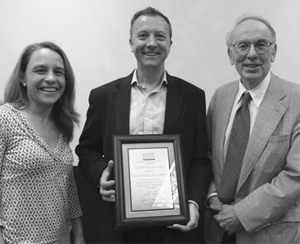
- Linkage Home
- DCEG Holds Annual Retreat
- DCEG Welcomes Visiting Scholar Paul Pharoah
- Christian Abnet: Seeking to Understand Cancer Risk
- Spring 2008 Intramural Research Award Winners
- Kai Yu Loves to Solve Problems
- NIH Recognizes 2009 FARE Winners
- Inaugural Meeting of THYGENE Consortium
- Monograph on Familial Cancer Syndromes Published
- An Update on the InterLymph Consortium
- 2008 DCEG Summer Fellows
- Koutros Wins Student Prize
- Consortium Will Focus on Esophageal Disease in Asia
- Recent Newsletters on Familial Cancer Research
- Zahm Receives Harvard School of Public Health Alumni Award of Merit
- DCEG Staff Win NIH Merit Awards
- Investigators Newly Awarded Tenure
- Committee of Scientists Update
- Power Calculator for Genetic Association Studies
- Scientific Highlights
- DCEG Staff Win NIH Director's Awards
- Internet2 IDEA Award
- DCEG People in the News
- Comings...Goings
- Sharon Miller Retires
- DCEG Staff at Work and Play
DCEG Welcomes Visiting Scholar Paul Pharoah

Montserrat García-Closas, Paul Pharoah, and Joseph Fraumeni.
In June, DCEG was honored to welcome Dr. Paul D.P. Pharoah for a two-day visit as a Visiting Scholar. Dr. Pharoah, a Cancer Research UK Senior Clinical Research Fellow in the Department of Oncology and the Strangeways Research Laboratory at the University of Cambridge, was hosted by Montserrat García-Closas, M.D., Dr.P.H., Hormonal and Reproductive Epidemiology Branch (HREB).
Dr. Pharoah began his career practicing general medicine. After spending a year in Malawi working on a vaccine to prevent leprosy, Dr. Pharoah decided to specialize in public health. Upon his return to the United Kingdom, he earned a Diploma in Public Health and accepted a research fellowship with the Cancer Research Campaign (now known as Cancer Research UK) Human Cancer Genetics Group, where he became involved in a study of familial breast cancer under the mentorship of Sir Bruce Ponder. It was here that Dr. Pharoah received the comprehensive, cross-disciplinary training in epidemiology, molecular genetics, and laboratory techniques that made him uniquely poised to pursue the independent research program in genetic epidemiology that has earned him worldwide recognition. His current research portfolio includes studies of common genetic variation and breast and ovarian cancer susceptibility, polygenic models of cancer susceptibility (i.e., gene-gene interaction), and the role of germline genotype in determining the clinico-pathological characteristics of breast and ovarian cancer.
The highlight of Dr. Pharoah’s visit was his seminar, titled “Common low-penetrance breast cancer susceptibility alleles: The clinical implications.” Dr. Pharoah showed that novel breast cancer genetic susceptibility loci might prove useful. “We need to change the way we think about prevention,” he urged. Genetic information could improve the ability to identify population subgroups at low and high risk in screening programs, which is more economical than the current practice of screening entire populations based on less predictive risk factors. In contrast, Dr. Pharoah demonstrated that using common susceptibility loci for individualized disease prevention is likely to be limited.
Following the seminar, Joseph F. Fraumeni, Jr., M.D., Division Director, presented Dr. Pharoah with the DCEG Visiting Scholar Award in recognition of his leadership and vision in cancer genetics and epidemiology.
Dr. Pharoah’s first roundtable discussion, moderated by Mark E. Sherman, M.D. (HREB), was dedicated to the etiologic heterogeneity of breast and ovarian cancer. William F. Anderson, M.D., M.P.H., Biostatistics Branch (BB), presented data from his recent work, which describes the epidemiologic patterns for histologic subtypes of breast cancer. Rose Yang, Ph.D., M.P.H., Genetic Epidemiology Branch, discussed her work on coexpression patterns of hormone markers and the identification of novel molecular subtypes of breast cancer. Dr. Pharoah then offered his perspective on which risk factors should be examined and what additional studies are still necessary. He emphasized that “even if a subtype classification is not prognostic, that does not mean that it is not biologically relevant.”
DCEG fellows had an opportunity to talk with Dr. Pharoah during a special luncheon session. He shared his experience as a graduate student and how he found his way to the field of cancer genetics and epidemiology. He encouraged young investigators to “be on the crest of the wave” of new technology by becoming “involved with new studies as the process of cutting-edge technologies to support them is under way.”
In a second roundtable discussion, moderated by Sholom Wacholder, Ph.D. (BB), Dr. Pharoah commented on the value of common susceptibility loci in risk prediction, screening, and prevention. He stated, “the key to the risk-benefit decision is to consider absolute risk for the individual” rather than relative risk. He again emphasized that even if the clinical relevance of epidemiologic research results may not be immediately discernable, “the biological impact should not be overlooked.”
Dr. Pharoah spent the remainder of his two-day visit in one-on-one sessions with other DCEG investigators discussing topics of mutual interest.
—Michael Donovan, Ph.D., and Alyssa Voss, M.P.H.
